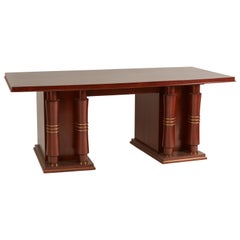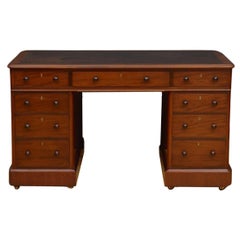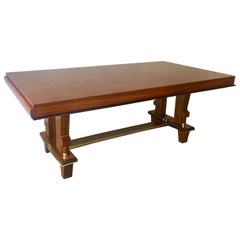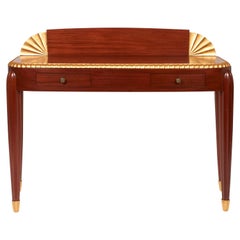Mahogany Desks and Writing Tables
2
to
2
2
2
2
2
2
1
1
1
Height
to
Width
to
Depth
to
5
4
3
2
2
2
2
125
9
7
5
5
Material: Mahogany
Creator: Jules Leleu
Jules Leleu Double Pedestal Mahogany Art Deco Desk with Gilt Bronze Details
By Jules Leleu
Located in St. Louis, MO
Jules Leleu (1883-1961) double-fronted mahogany and brass desk, circa 1935.
Having two set of four pedestal drawers and a single frieze drawer, accented in gilt bronze. Inset with p...
Category
1930s French Art Deco Vintage Mahogany Desks and Writing Tables
Materials
Bronze
French Art Deco Leleu Mahogany Kneehole Desk
By Jules Leleu
Located in New York, NY
French Art Deco large mahogany kneehole desk with bronze column design trim and leather top. (JULES LELEU)
Category
Early 20th Century French Art Deco Mahogany Desks and Writing Tables
Materials
Bronze
Related Items
Dakota Jackson French Art Deco Postmodern Mahogany Executive Partners Desk 96"
Located in Dayton, OH
Vintage Dakota Jackson post modern Art Deco style executive partners desk featuring mahogany with leather insert and stainless steel frame. A V-Shape pattern veneer top with Black Leather inset. 2 pedestal cabinets below: each with 2 standard drawers and 1 file drawer, front and back. Polished Stainless Steel drawer pulls, post, floor plates, and arced trestle supporting desktop. DJ Chelsea Black Leather, Polished Polyresin finish.
Dakota Jackson (born August 24, 1949) is an American furniture designer known for his eponymous furniture brand, Dakota Jackson, Inc.,[1] his early avant-garde works involving moving parts or hidden compartments,[2][3] and his collaborations with the Steinway & Sons piano company.[1]
Jackson helped establish the art furniture movement in 1970s SoHo,[4][5] later becoming a celebrity designer in the 1980s.[6][7][8] His background in the world of stage magic helped him get his first commissions and is often cited as the source of his point-of-view.[6][9]
Early life
Dakota Jackson was born on August 24, 1949, and grew up in the Rego Park neighborhood of Queens, New York.
Stage Magic
Jackson's father, Jack Malon, was a professional magician.[10] Mr. Malon learned the trade from his own father, who studied stage magic in early 20th century Poland.[1]
Jackson began studying magic at a young age and sometimes performed with his father.[11] Jackson's name, in fact, grew out of a road trip to Fargo, North Dakota.[11]
Throughout his adolescence and into his early 20s, Jackson immersed himself in the world of magic.[2] In 1963, Jackson began to perform in talent shows at his junior high school, William Cowper JHS 73 (which is known today as The Frank Sansivieri Intermediate School),[12] and at children's birthday parties.[13] Jackson also began to build his own props, including large boxes for sawing a woman in half and small boxes from which doves would emerge in full flight.[11] Jackson acknowledges the importance of these early experiences with magic to his later career as a furniture designer: "The demands of performance taught me how to discipline myself to achieve aesthetic ends."[1][2][14]
After Jackson graduated from Forest Hills High School in 1967, he continued performing as a magician, working in art galleries, night clubs, touring in the Catskills, and giving private performances at society events.[2][13][15] When he was 17, Jackson had studied with magician Jack London to learn the dangerous bullet catch trick.[16]
"What appealed to me was the notion of doing things that appeared miraculous" Jackson once recalled.[6] "I was interested in spiritualism. I was interested in things like bullet catching, things that really challenged individual sensibilities, that were frightening, on the edge."[2]
He didn't find the opportunity to perform the trick publicly until a decade later at Jackson's final professional performance as a magician.[1] It was documented in Andy Warhol's Interview (magazine), in a story titled "Dakota Jackson bites the bullet."[1][16]
Jackson admits that he sometimes tires of references to his magician background, although he acknowledges it as an important part of his history.[2]
The Downtown Arts Scene
In the late 1960s, Jackson moved into a loft on 28th Street in Chelsea.[1][17] Jackson became part of the Downtown scene, a community of "artists, dancers, performers, and musicians" who moved to the neighborhood for the cheap rent and social life.[1][8][17][18]
In October 1970, Jackson performed with the Japanese group Tokyo Kid Brothers at New York's La MaMa Experimental Theatre Club (also known as Café La MaMa) in a rock musical production called "Coney Island Play" ("Konī airando purē).[19] The show explored themes of cross-cultural communication and understanding[19] and was a follow up to the group's debut performance of "The Golden Bat" at La MaMa earlier that summer.[20][21][22] Jackson played the part of a "clever conjurer."[19]
Over the next few years, Jackson became interested in minimalist dance and performed in the dance companies of Laura Dean and Trisha Brown.[2][15][23]
Jackson credits his exposure to minimalism and minimalist dance in particular as having had a strong influence on his approach to design; in 1989, Jackson told the Los Angeles Times:
For me the essential fineness of a design is in the idea, not the object itself ... In minimalism, the object is pared down to its basic meaning by stripping away all the excrescence ... —those elements that do not contribute to the pure idea.[24]
Design career
In the early 1970s, as he experimented with performance and dance, Jackson began branching out as a special effects consultant to other magicians, film producers, and musicians[2][23] such as Donna Summer.[6][9]
The loft also gave Jackson an opportunity to apply his creativity and building skills: "These were times when lofts were not ... luxury condominiums. These were tough, tough raw spaces ... and we artists, bohemians, creative people, we created our environment. So I had to build".[17][25]
Recognizing his skills as a builder, Jackson decided to shift away from performance and become a full-time maker.[1][15][17] He began making a variety of objects, including furnishings for other artists and magic boxes with hidden compartments for art collectors and galleries.[17][24] Jackson's social connections helped spread word about his work[15] and this led to his first commissions.[1]
Early Commissions
Desk for John Lennon by Dakota Jackson
In 1974, Jackson's career as a designer began when Yoko Ono asked him to build a desk with hidden compartments for husband John Lennon.[26] "She wanted to make a piece of furniture that would be a mystical object; that would be like a Chinese puzzle," Jackson recalled in a 1986 interview published in the Chicago Tribune.[6] The result was a small cubed-shaped writing table with rounded corners reminiscent of Art Deco era style.[15] Touching secret pressure points opened the desk's compartments.[23] This commission helped build Jackson's reputation and allowed him to merge his experience as a magician and performer with his developing interest in furniture.[27]
In 1978, a bed designed for fashion designer Diane von Furstenberg garnered Jackson even more notoriety.[8][10][28] [29] Called "The Eclipse", the bed was described in The New Yorker as "large, astounding, sumptuous, with sunbursts of cherry wood and quilted ivory satin at head and foot."[10] A lighting system positioned behind the headboard switched on automatically at sunset and spread out rays of light "like an aurora borealis,"[2][17] which grew brighter and brighter until turning off at 2 am.[23][30]
Commissions like these continued to come in[8] and Jackson soon became known as a designer to the rich and famous.[30] Some of his other clients from this period included songwriter Peter Allen, Saturday Night Live creator and producer Lorne Michaels, Rolling Stone publisher Jann Wenner, and soap opera actress Christine Jones.[8]
The American Art Furniture Movement and the Industrial Style
In the late 1970s, Jackson was among a small group of artists and artisans producing and exhibiting hand-made furniture in New York.[5][31] Jackson and his peers were part of the "American Art Furniture Movement," a group sometimes called the "Art et Industrie Movement,"[32] named after the leading art furniture gallery of the era,[32] Art et Industrie, founded by Rick Kaufmann in 1976.[33]
In a 1984 Town & Country article titled "Art You Can Sit On," Kaufmann said he created the gallery to "serve as a locus to the public for artists and designers creating new decorative arts."[31] The works on display were "radical objects" that drew from a number of fine art traditions, including "Pop, Surrealism, Pointillism and Dada [which were] "thrown together with the severe lines of the Bauhaus and the Russian avant-garde, mixed with Mondrian's color and filtered through a video sensibility—all to create a new statement."[31] The article described Jackson as a "ten-year veteran of the genre" and pointed to the "clean forms and quiet colors" of his furniture.[4]
Jackson showed a variety of industrial-looking lacquer, metal, and glass works at Art et Industrie, including his Standing Bar (also known as the Modern Bar),[33] a lacquered cabinet that Jackson designed in 1978 for his wife (then-girlfriend) RoseLee Goldberg.[13]
Other works from this period include the T-Bird Desk, Self-Winding Cocktail Table, and the Saturn Stool...
Category
Late 20th Century Art Deco Mahogany Desks and Writing Tables
Materials
Stainless Steel
H 30 in W 96 in D 42 in
Victorian Mahogany Pedestal Desk
Located in Whaley Bridge, GB
Sn5445 Victorian mahogany pedestal desk, having original leather to the top above three frieze drawers and further three graduated cedar and mahogany lined drawers with figured mahog...
Category
19th Century English Antique Mahogany Desks and Writing Tables
Materials
Mahogany
French Art Deco Table by Jules Leleu
By Jules Leleu
Located in Paddock Wood Tonbridge, GB
FRENCH ART DECO TABLE BY JULES LELEU
A French Art Deco dining table produced by Jules Leleu around the1940’s in straight grain walnut with parquetry and segmented inlay highlighted w...
Category
1940s French Art Deco Vintage Mahogany Desks and Writing Tables
Materials
Walnut
Art Deco Desk, France 1940s
Located in Greding, DE
Art Deco desk with slightly curved table top and two drawer elements with four drawers each. These are lockable and the handles are made of elegant bars. The desk can be positioned a...
Category
1940s French Art Deco Vintage Mahogany Desks and Writing Tables
Materials
Wood
18th Century George II Mahogany Kneehole Desk
Located in Dublin 8, IE
18th century George II mahogany knee hole desk, with one long drawer above central cupboard door flanked by six short drawers raised on bracket...
Category
18th Century Irish George II Antique Mahogany Desks and Writing Tables
Materials
Mahogany
French Art Deco Desk
Located in Westwood, NJ
In the Ruhlman Manner, this French Art Deco desk, true to its French lineage, is a study in curves and angles. Two shapely filing drawers flank th...
Category
21st Century and Contemporary Vietnamese Art Deco Mahogany Desks and Writing Tables
Materials
Mahogany
Inlaid Satinwood Double Pedestal Desk
Located in Pasadena, CA
This is a very attractive and unusual Mid-19th Century satinwood double pedestal desk. True 19th century satinwood is an expensive, very desirable and rare. The wood is fine grained, but figured, and used principally in veneer work and in inlay. The combination of the the pale satinwood outlined with the graphic faux ebony outlining of the drawers and top, combined with the scrolling detailed inlay, creates a unique piece with great visual interest. Currently the drawers must be opened with a key. We have ordered appropriate 19th century-style bail pulls...
Category
Mid-19th Century English Victorian Antique Mahogany Desks and Writing Tables
Materials
Brass
1950s Art Deco Pedestal Desk in Walnut & Ebonized Finish with Brass Accents
Located in Los Angeles, CA
Immerse yourself in the elegance of the past with our 1950s Art Deco Pedestal Desk, a perfect blend of historical charm and modern restoration. ...
Category
1950s American Art Deco Vintage Mahogany Desks and Writing Tables
Materials
Brass
Oak Art Deco Desk with Bronze Handles
By Abbess
Located in London, GB
A freestanding oak Art Deco style pedestal desk with bronze handles by Abbess.
Each pedestal having one writing slide over four drawers with bronze han...
Category
Mid-20th Century English Art Deco Mahogany Desks and Writing Tables
Materials
Bronze
Mahogany Pedestal Desk
Located in Cheshire, GB
Large mahogany pedestal desk the rectangular top with inset leather having tooled border enclosed by a moulded edge over an arrangement of three freeze drawers. Above two large pedes...
Category
Early 20th Century British Mahogany Desks and Writing Tables
Materials
Wood
Renaissance Revival Kneehole Desk
Located in New York, NY
Renaissance Revival kneehole desk, with rectangular walnut top above a white painted two pedestal desk, with one long and two short drawers above two cab...
Category
19th Century Renaissance Revival Antique Mahogany Desks and Writing Tables
Materials
Walnut
French Art Deco Desk/Vanity
Located in Austin, TX
Desk, vanity, from France made of figured walnut. This piece is finished in a lustrous French polish finish and features a dovetailed single drawer hidden in the apron.
Category
1930s French Art Deco Vintage Mahogany Desks and Writing Tables
Materials
Walnut
Previously Available Items
Jules Leleu French Art Deco Extendable Dining Table
By Jules Leleu
Located in Miami, FL
A stunning French Art Deco dining table by Jules Leleu. This fine table can also be used as a desk, conference room or writing table. Recently refinished with a bar top varnish.
M...
Category
Early 20th Century French Art Deco Mahogany Desks and Writing Tables
Materials
Brass, Bronze
Jules Leleu, Lady's Writing Desk in Mahogany Wood and Golden Leaves, circa 1925
By Jules Leleu
Located in Paris, FR
Lady's writing desk, circa 1925.
Lady's writing desk in mahogany wood opening by two drawers in the belt, with a rectangular round-angled tray decorated with a notched upper friez...
Category
1920s French Art Deco Vintage Mahogany Desks and Writing Tables
Materials
Gold Leaf
H 35.44 in W 45.28 in D 19.69 in
Jules Leleu, Mahogany writing table, France, c. 1940
By Jules Leleu
Located in New York, NY
Mahogany and gilt-bronze writing table with two drawers by Jules Leleu
For an illustration of an identical table, see Siriex, Françoise. The House of Leleu. New York: Hudson Hills...
Category
1940s French Vintage Mahogany Desks and Writing Tables
Materials
Bronze
1940's French Mahogany Desk by Jules Leleu
By Jules Leleu
Located in New York, NY
Signed by French designer Jules Leleu, this 1940's table desk is composed of brass trimmed mahogany with a rectangular top with a small brown leather writing area above three drawers...
Category
1940s French Art Deco Vintage Mahogany Desks and Writing Tables
Materials
Brass
Jules Leleu, Mahogany Vanity, France, 1945
By Jules Leleu
Located in New York, NY
Mahogany writing table or vanity by Jules Leleu with its original mirror, and patinated and gilt bronze details
Signed "JLeleu" on upper front leg
Provenance: Designed by Leleu...
Category
1940s French Vintage Mahogany Desks and Writing Tables
Materials
Bronze
1940's Glass Top Mahogany Desk by Jules Leleu
By Jules Leleu
Located in New York, NY
Signed by French Art Deco designer Jules Leleu, this four legged 1940s mahogany desk features three drawers and bronze trim under a molded top sheathed in glass. The piece is finishe...
Category
1940s French Art Deco Vintage Mahogany Desks and Writing Tables
Materials
Bronze
Recently Viewed
View AllMore Ways To Browse
Bureau Plat Bronze
Xvi Bureau
Gilt Antique Writing Desk
Black Walnut Writing Desk
Writing Desk Table Neoclassic
Tall Writing Desk
Italian Mid Century Walnut Desk
Walnut Desk Turned Legs
Turned Leg Walnut Desk
Mahogany Galleried Desk
Folding Writing Table
Antique Desk Writing Set
Vintage Midcentury Modern Walnut Desk
Mahogany Partners Desk 19th Century
Scalloped Desk
Antique Writing Desk Green
Small Deco Desk
French Desk W Drawers




